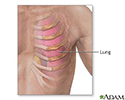Costochondritis
Chest wall pain; Costosternal syndrome; Costosternal chondrodynia; Chest pain - costochondritisAll but your lowest 2 ribs are connected to your breastbone by cartilage. This cartilage can become inflamed and cause pain. This condition is called costochondritis. It is a common cause of chest pain.
Chest pain
Chest pain is discomfort or pain that you feel anywhere along the front of your body between your neck and upper abdomen.

Causes
There is often no known cause of costochondritis. But it may be caused by:
- Chest injury
- Hard exercise or heavy lifting
- Viral infections, such as respiratory infections
- Strain from coughing
- Infections after surgery or from intravenous (IV) drug use
Intravenous
Intravenous means "within a vein. " Most often it refers to giving medicines or fluids through a needle or tube inserted into a vein. This allows th...
Read Article Now Book Mark Article - Some types of arthritis
Types of arthritis
Ankylosing spondylitis (AS) is a chronic form of arthritis. It mostly affects the bones and joints at the base of the spine where it connects with t...
 ImageRead Article Now Book Mark Article
ImageRead Article Now Book Mark Article
Symptoms
The most common symptoms of costochondritis are pain and tenderness in the chest. You may feel:
- Sharp pain at the front of your chest wall, which may move to your back or stomach
- Increased pain when you take a deep breath or cough
- Tenderness when you press the area where the rib joins the breastbone
- Less pain when you stop moving and breathe quietly
Exams and Tests
Your health care provider will take your medical history and do a physical exam. The area where the ribs meet the breastbone is checked. If this area is tender and sore, costochondritis is the most likely cause of your chest pain.
A chest x-ray may be done if your symptoms are severe or do not improve with treatment.
Chest x-ray
A chest x-ray is an x-ray of the chest, lungs, heart, large arteries, ribs, and diaphragm.

Your provider may also order tests to check for other conditions, such as a heart attack.
Treatment
Costochondritis most often goes away on its own in a few days or weeks. It can also take up to a few months. Treatment focuses on relieving the pain.
- Apply hot or cold compresses.
- Avoid activities that make the pain worse.
Pain medicines, such as ibuprofen (Advil, Motrin) or naproxen (Aleve), may help to ease pain and swelling. You can buy these without a prescription.
- Talk with your provider before using these medicines if you have heart disease, high blood pressure, kidney disease, liver disease, or have had stomach ulcers or internal bleeding in the past.
- Take the dose as advised by the provider. Do not take more than the amount recommended on the bottle. Carefully read the warnings on the label before taking any medicine.
You may also take acetaminophen (Tylenol) instead, if your provider tells you it is safe to do so. People with liver disease should not take this medicine.
If your pain is severe, your provider may prescribe stronger pain medicine.
In some cases, your provider may recommend physical therapy.
Outlook (Prognosis)
Costochondritis pain often goes away in a few days or weeks.
When to Contact a Medical Professional
Call 911 or the local emergency number, or go to your local emergency room right away if you have chest pain. The pain of costochondritis can be similar to the pain of a heart attack.
If you have already been diagnosed with costochondritis, contact your provider if you have any of the following symptoms:
- Trouble breathing
- A high fever
- Any signs of infection such as pus, redness, or swelling around your ribs
- Pain that continues or gets worse after taking pain medicine
- Sharp pain with every breath
Prevention
Because the cause is often unknown, there is no known way to prevent costochondritis.
References
Crasto JA, Vaswani RS, Pauyo T, Musahl V. Overview of sport-specific injuries. In: Miller MD, Thompson SR. eds. DeLee, Drez, & Miller's Orthopaedic Sports Medicine. 5th ed. Philadelphia, PA: Elsevier; 2020:chap 9.
Hanak JA. Tietze syndrome. In: Frontera WR, Silver JK, Rizzo TD Jr, eds. Essentials of Physical Medicine and Rehabilitation: Musculoskeletal Disorders, Pain, and Rehabilitation. 4th ed. Philadelphia, PA: Elsevier; 2019:chap 117.
Kurz J. Costosternal syndrome. In: Frontera WR, Silver JK, Rizzo TD Jr, eds. Essentials of Physical Medicine and Rehabilitation: Musculoskeletal Disorders, Pain, and Rehabilitation. 4th ed. Philadelphia, PA: Elsevier; 2019:chap 101.
-
Ribs and lung anatomy - illustration
The ribs are the skeletal protection for the lungs and the chest cavity. The ribs and rib muscles expand and contract with normal breathing.
Ribs and lung anatomy
illustration
Review Date: 10/9/2024
Reviewed By: Linda J. Vorvick, MD, Clinical Professor, Department of Family Medicine, UW Medicine, School of Medicine, University of Washington, Seattle, WA. Also reviewed by David C. Dugdale, MD, Medical Director, Brenda Conaway, Editorial Director, and the A.D.A.M. Editorial team.



